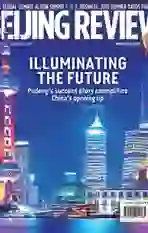The People’s Museum
2018-10-23ByRebecaToledo
By Rebeca Toledo
As a frequent museum-goer, I was absolutely thrilled by my visit to the National Museum of China. It was not what I expected, but then again things in China hardly ever conform to a mindset cultivated in the West, which is a good thing in my opinion.
The museum, situated on the east side of Tiananmen Square in Beijing, was built after the 1949 founding of the Peoples Republic of China and houses the most important cultural and historical relics in the country.
I daresay the actual building and entrance—as appealing as they were—looked like many other prominent museums Ive seen. However, just after walking in, I could sense that this was going to be a different museum experience.
It was extremely crowded, of course, as things in Beijing tend to be, but that wasnt it. It contained a labyrinth of Chinese characters that I couldnt understand, but that wasnt it either.
The first thing I noticed was that people were actually talking to each other, something that Western museums in general seem to frown upon.
Secondly, the children didnt look bored, something Ive always noticed to be the case in most prestigious museums in the West.
As I walked further in and headed to the exhibition celebrating the 200th anniversary of Karl Marxs birth, I also noticed that people were eating in corridors, something I often want to do in museums just to keep my stamina up for the long day.
People were also taking selfies and group photos everywhere, and I mean everywhere! How often I have wished to take a photo at a museum!
Then, as I went in search of the teeth of Yuanmou Man from 1.7 million years ago, I saw people touching glass cases and even taking video footage. This totally floored me and I quickly began to do the same. A vigilant cleaning staff kept everything nearly spotless.
Next, after successfully finding the Houmuwu Rectangle Ding, the biggest piece of ancient bronzeware in the world from the Shang Dynasty (1600-1046 B.C.), I was simply enthralled by people sitting around chatting and seemingly have a good time.
Needless to say, this has not been my overall museum experience. As a life-long student of history, I have visited major museums all over the world and as a long-time resident of New York City, I frequented distinguished museums regularly.
But for the most part, I usually feel like a little girl in someone elses home after my mother has had the “dont touch anything, dont do anything, dont eat anything, dont speak unless spoken to” talk with me.
Walking into a typical first-rate museum usually requires this type of extreme self-control. Im in constant fear of getting escorted out by the guards posted everywhere. I feel like I have to be as quiet as humanly possible. Advisories all around warn me to abstain from touching or taking photos of anything. Places to sit or even rest are excruciatingly limited.
But then there is the museum café, which I usually go running to as if an oasis, always forgetting that the food is overpriced and unsatisfying.
Although admittedly, I am usually treated to amazing and certainly worthwhile exhibits, overall I leave these museums in a tense, hungry and tired state.
But this was not the case at the National Museum of China. As a veteran (six months) resident of Beijing, I know to carry snacks and water at all times. So I was able to eat my baozi, drink my water and even have my mango.
I sat on the stairs whenever I got the urge and listened to the Chinese language all around me, trying to pick up some words. I took photos of a huge display of all the languages the Communist Manifesto has been translated into.
As I walked out of the generously air-conditioned building into the sauna-like summer heat after spending over fi ve hours discovering some of the museums treasures, I realized I wasnt too tired, and in fact felt well-fed, wellwatered and relaxed.
Although Beijing, and China in general, can be overwhelming and intimidating, I have found time and again that the countrys attempt to focus on people makes everything just a little bit easier. My experience at the national museum brought to mind the feeling I often get here, which is that China really does try to make peoples lives better. Its not perfect, its not utopian, but there is something special about it.
As I walked to the metro station, satisfi ed and happy, I began planning my next visit to what I was already dubbing the peoples museum.
